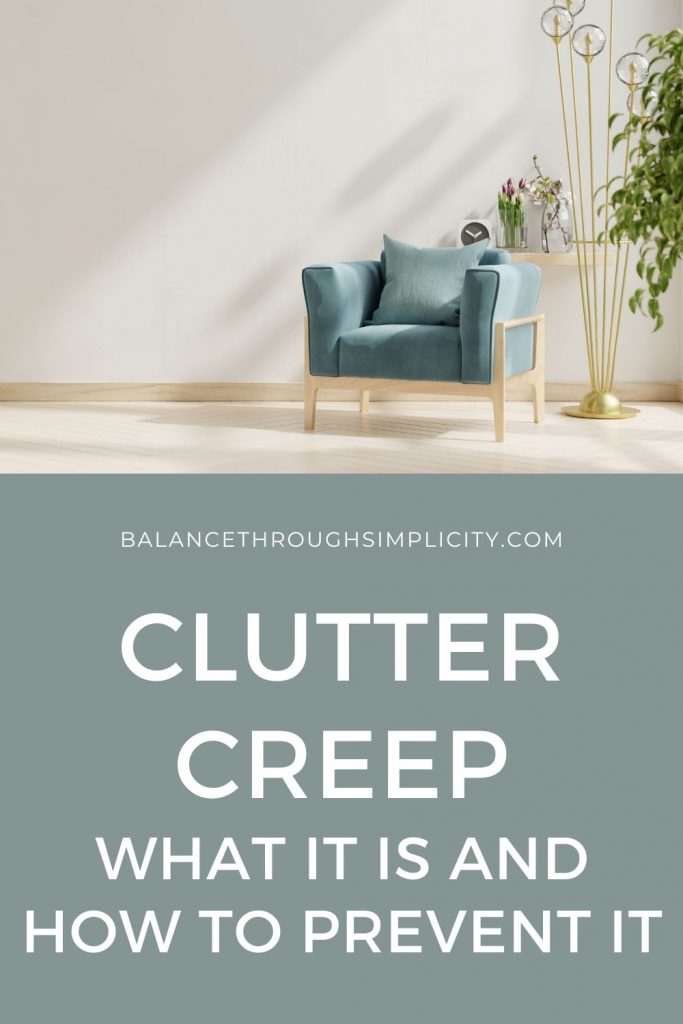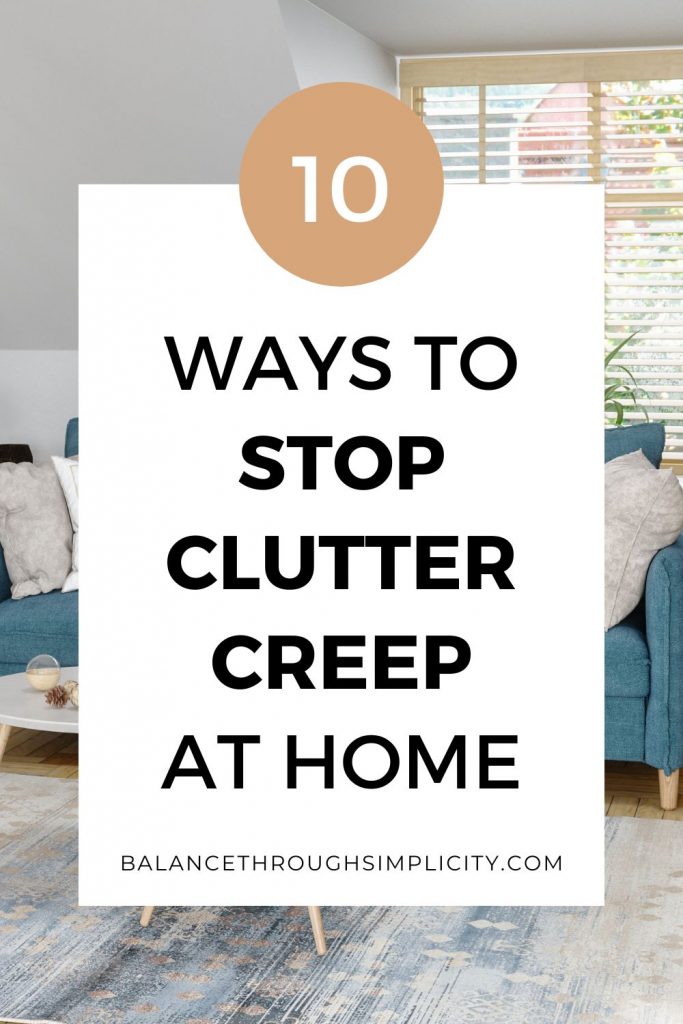CLUTTER CREEP: WHAT IT IS AND HOW TO PREVENT IT
Decluttering our homes isn’t a project you can do once and tick off your list. Clutter invades our homes slowly and steadily unless we have some strategies in place to keep the clutter away. In this article I’m looking at clutter creep, what it is and how to prevent it!
WHAT IS CLUTTER CREEP?
If you’ve ever decluttered your home, you’ll probably realise that it’s pretty futile unless you have some systems in place to keep the clutter away going forward. Clutter invades our homes and lives in many different ways.
Here are some examples that you’re probably familiar with:
- Spam emails in your inbox
- Packaging with your food
- Junk mail through your letterbox
- Bargains in the shop you couldn’t resist
- Home décor items that you think look cute
- Papework you need to deal with
- Your child’s pieces of art and lego creations
These are all different types of clutter that build up on a regular basis. Although on their own they might be small and insignificant, if you could fast forward and watch it back on replay you might be surprised at how small bits of clutter gradually make a home feel and look cluttered. This is clutter creep.
WHY OUR CLUTTER BUILDS UP
Clutter is sneaky and it comes into our homes when we’re not looking or paying attention. We all know about keeping our clutter hotspots, such as table tops and entrance ways, clear so clutter can’t attract clutter. We know to look in drawers and cupboards for hidden clutter. We know the pitfalls of keeping ‘just in case clutter’ should we need it at some point.
However, clutter still creeps into our homes slowly but surely until our home feels cluttered and we’re back to where we started – needing to declutter yet again. This clutter cycle is frustrating, demotivating and can be broken with a few strategies in place to stop our clutter creeping in… and round our home.
WHY CLUTTER CREEPS
This is the other thing about clutter creep. It’s not just clutter that comes in through the front door and sits there until we deal with it. Clutter creep is when the clutter finds its way around the house too.
Yes, it may come in via a bag or your child’s pockets, but then it gets emptied out on to the kitchen counter or the floor. From there, we move it to the side or take it upstairs to deal with, but that just means we’ve moved the clutter from its original point of entry to just another place in the home. It’s not preventing clutter creep in the first place.
Another example could be home décor items. You buy a pretty candle from a shop and place it in your home, then you see another one you like whilst out shopping so you buy that one too. Now you have two but two looks too much so you move the first one to another room and keep the second candle in situ. Now you have two candles and another example of where clutter has crept from one room to another around your home.
These are just a couple of examples of how clutter creep happens, whether we realise it or not. Soon, sure enough, our homes feel and look cluttered and the benefits of decluttering that we felt to begin with disappear as quickly as our clutter creeps!

HOW TO STOP CLUTTER CREEP
In this article I’d like to share some simple strategies to prevent clutter creep.
1. Be aware of clutter
The first point is to actually be aware of clutter. When you look around your home, and even before you bring any items into your home, think about what that item means to you. Is it going to add value, how often will you use it, do you have something similar, can you make do without it, where will you store the item? These decluttering questions will help you identify what’s clutter in your home and what’s not.
Raising your general awareness of the stuff in your home and how you perceive its value (not just monetary) will help you guage whether that stuff is clutter or not. Then you’ll know how best to deal with it. Read more about the different types of clutter in your life and how to deal with them.
2. Break the clutter cycle
The clutter cycle is the constant struggle that many of us against our clutter. We declutter our homes and then, without strategies in place to stop the clutter building up, end up having to declutter again before long.
Just like being aware of the clutter in your home like I mentioned earlier, being aware of the cycle of clutter coming into and out of your home is a good way to measure the progress of your clutter creep. Read more about the clutter cycle and how to break it.
3. Stop buying things you don’t need
Getting rid of the stuff in our homes is one thing, but many of us just then continue to bring new stuff in our homes which adds to the clutter. Stop clutter creep right at the outset by being mindful and intentional about your shopping habits. We all need to go shopping every now and then, and I’m certainly not saying that shopping isn’t an enjoyable way to spend some free time, but the key is to shop responsibly. Before you buy something, consider whether you really need, love or will use it.
Stop buying things you don’t need which just add to your clutter and your clutter creep, once you get them home. Read these tips on how to shop more intentionally and avoid those impulse buys that we often later regret.
4. Get comfortable with getting rid of things
By getting rid of things I mean donating, recycling, gifting, throwing away and selling. How you get rid of items will depend on what they are, what condition they’re in and how quickly you want to get rid of them. Here are some ideas for what to do with your unwanted stuff.
However, getting rid of things isn’t always easy. We hold onto items just in case we need them, because we feel guilty for spending money and now wasting it, because something has emotional value or was given to us as a gift.
Decluttering is like a muscle, the more you use it then the stronger it gets. Get comfortable with the physical and emotional aspects of decluttering and you’ll find it easier to stop clutter creep. Read more about how to declutter without feeling guilty or wasteful.

5. Make decluttering easy
It has to be as easy to get rid of something as it is to keep it. At least, that’s the rule in my home or else my kids and husband wouldn’t ever get rid of things! Keep a donation box in an obvious and accessible place, for example by the front or back doors. Let your family know it’s there and that they (and you) can pop stuff in there that’s no longer wanted or needed. This way it’s really easy to declutter.
Ask your family or yourself to sort the stuff, put it up in the loft or tucked away in the garage, and it’s unlikely any of you will be motivated enough to use it. It’s much easier to stuff your unwanted clutter right back where it came from and so the clutter creep continues.
6. Make decluttering a regular habit
As well as being easy, decluttering needs to be a regular habit to prevent clutter creep. It’s no good decluttering one weekend and then not decluttering again for 6 months. You won’t be flexing your decluttering muscles and the amount of clutter that’s built up in that time between decluttering sessions will probably be off-putting and overwhelming.
Decluttering can be really effective when it’s done in little blocks of time regularly. Mark a day and time in your calendar, for example in our home it’s every Thursday when the rubbish and recycling is collected, and put an alert or reminder on your phone which you stick to. Do this regularly, every week or month, to prevent clutter creep with consistent decluttering.
7. Use the 1 in, 1 out rule
When you bring something new into the home, make a pact to get rid of one thing in return. This is the 1 in, 1 out rule and it’s a handy little strategy for preventing clutter creep. The added bonus is that you can still feel like you’re getting new stuff but you’re letting go of something that you don’t want to keep instead so the clutter never really builds up.
Although handy, use this approach with caution because it can mean you don’t think clearly about what you’re bringing into your home. You might just be relying on the fact that you’ll be letting something go instead.
8. Get clear on your priorities
Deciding what’s important to you is a great way of making decisions about what clutters your home. Do you want more time for fun, family and life in general or are you happy to spend your time looking after your home and managing the stuff in it?
In the season of life I’m in right now, juggling kids and work, it’s important for me to have a home that functions well for us but that’s simple and easy to manage. I don’t have time to be dusting tiny ornaments and plumping up a million decorative cushions. So, I choose not to buy either of these things because I know that they’ll take up time which I’d rather be spending elsewhere.
Everything in your home sends out messages about what it requires of you, for example, your potted plants need watering. Deciding on your priorities based on the messages your clutter sends out to you is a good way to define your priorities and stop clutter creeping around your home. Read more about the Silent To Do list.
9. Say no
It’s a small but powerful word. If you don’t want something cluttering up your home, say no thank you. It’s your home, your choice. You can find more subtle ways of saying no, rather than just ‘no’, but the end result can still be a no.
10. Borrow things you don’t need to buy
I stopped buying books because I borrow them from the library. If we need camping equipment we borrow them from a friend. Items you don’t use regularly could be borrowed or rented instead of taking up space in your home.
As Francine Jay says, “Your home is living space, not storage space” so try to make sure that everything in your home repays the value of you keeping it. Apart from anything else, that means using it regularly!
11. Use storage but use it wisely
Another good tip to prevent clutter creep is to use storage to keep your stuff in when not in use. Always put things away when you’ve finished using them and if you buy or bring something new into the home, make sure you know where it’s going to be kept. This means your stuff won’t just be lying around to clutter up surfaces or be left in random places. The trick, of course, is getting your family to also put stuff away when they’ve finished using them. Patience and perseverance, I think, are the key here!
Using storage also helps you define how much of an item to keep. A book shelf or shelves is a good example of this. Decide how many shelves you want to devote to storing your book collection. When you have too many books to comfortably sit on these shelves then it’s time to sift through and get rid of some. Using storage in this way means that your books and other clutter won’t creep around the home. They have a definite home to live in and that’s where they should stay when not in use!

CONCLUSION
I hope this article has given you some ideas about clutter creep, what it is and how to prevent it. Take a look around your home now and see if you can spot some clutter that’s crept from room to room. What can you do to tackle clutter creep for yourself? I’d love to hear your thoughts on what types of clutter creeps its way the most around your home? What strategies do you use to tackle it? Leave a comment below!
SIMPLIFY YOUR HOME
To achieve and feel the benefits of a decluttered home for yourself, it takes motivation, time and willpower. Sometimes we struggle with finding these but to make it easier to clear your clutter I created Simplify Your Home.
Simplify Your Home is a guide, workbook and decluttering checklists which will take you step-by-step around your home decluttering as you go.
I offer lots of decluttering tips, hacks and practical advice to overcome common decluttering problems.
Everything is all laid out for you so all you have to do is follow the steps and action points and use the checklists to create your own decluttered home.
Hopefully you’ll feel the benefits we’ve talked about in this article and avoid clutter creep!
Click here to read more about Simplify Your Home.
YOUR NEXT STEP…
If you’d like to try decluttering for yourself, I’ve put together a free guide and workbook to help you get started. We explore ways you can declutter your own home, solutions to common problems, and how decluttering is just the first step to a simpler life for you.
Pop your details in the box below to get started…
DON’T MISS OUT!
I’m Antonia and on this blog I share practical inspiration to simplify your home, time and life. Follow me on Instagram, Facebook and Pinterest! You can also subscribe to Balance Through Simplicity and receive regular simplicity tips straight to your inbox for free. Make sure you never miss an article plus you’ll get a copy of my free Declutter Starter Kit as a welcome gift!

